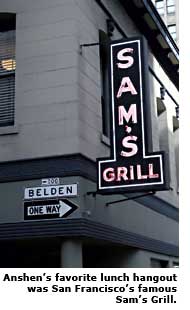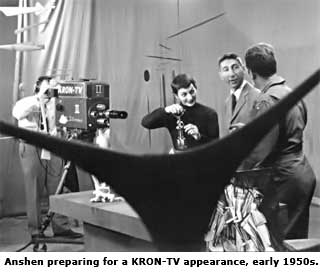Eichler Architect, Bob Anshen: Self-Made Man - Page 4
It was Anshen who set the tone for the office. Donald Olsen remembers a conference room that was significantly larger than the drafting room. "He had a conference table, it must have been 12 feet long at least, and in one corner there was a thing that held a big bottle of scotch upside down with a dispenser and glasses. Then, in the opposite corner, 12 feet away, was the same sort of thing, a huge dispenser of bourbon."
Like Eichler, Anshen and Allen's favorite restaurant was Sam's Grill, in downtown San Francisco. "An employee who didn't accept (Anshen's) invitation for a 'quick meal at Sam's' never really became part of the office," architect Woody Stockwell wrote in his memoir, 'When the Lions Come.'
"Having rarely eaten breakfast, Bob's daily sustenance began with two dry martinis, straight up. A New York steak usually followed this, but I always had the feeling that the entree was just for show."

Many architects returned to their drafting boards groggy—but Anshen, none the worse, would head off to a meeting. "It was a very happy office," Rath says, adding, "It was loose, put it that way."
"Bob was a master of telling stories," says Olsen. "He could go on and on with great detail."
"He told one joke for a week," Jack Hillmer recalled, "and we would hear him tell it to different people. But he would embellish it and make it better each time."
"One day I came into the office when we were sharing the drafting room," Callister added. "Bob was going through a card file. It was a card file of jokes. The reason he always had a joke, he took the front card and put it to the back."
"He was put out that I caught him, I think."
Anshen was easy to anger and often difficult to work with—though employees and clients forgave him because of his endearing qualities. He and Allen fought often, Derek Parker remembers, but made up readily. "Bob used to fire me regularly once a week, but I was always too busy to leave," Parker says.
Anshen and Allen, "Frank Lloyd Wright aficionados but not devotees, if you see the difference," according to Bay Area architect Henrik Bull, developed a style that was in conscious opposition both to the historical, Beaux-Arts styles in which they were trained, and the International Style of Mies van der Rohe.
"We felt we were fighting the International School; that was the enemy, as far as we were concerned," Allen told historian Joanne Stewart Wetzel.
Anshen, who loved to hector his colleagues at conventions, took the opportunity in 1962 to lambaste Mies' and Philip Johnson's Seagram Building in New York—then and now an International Style monument—as an example of "thin, sterile boxes, flat-faced nonentities with no quality of delight."

"We're sick of the glass box," he announced.
Successful as he was at corporate architecture, Anshen, his son John says, was always an artist at heart. He gravitated to the bohemian scene—though he never looked like a bohemian. "He always dressed the same," Ned Eichler remembers. "He wore a gray suit with a vest, a white shirt with a knit tie, and black shoes and white socks."
The Anshens lived in the city during the early years of the firm. "He and Ellie used to ride horses in Golden Gate Park early in the morning before coming to the office," architect and friend Jack Hillmer recalled—the only athletic endeavor friends recall Anshen undertaking.
The couple split after Bob met the beautiful Frances Ney at a dinner. Are you married, she asked. His reply, John says, was, "Yes. But..." They began dating after he divorced.
Anshen was already part of the San Francisco artistic and literary scene, friends with sculptor Bennie Bufano, Beat writer Lawrence Ferlinghetti, and others. Ney, whom he married around 1956, put him at the center of it through her friendship with writers Henry Miller and Frieda Lawrence and other artists from the Carmel-Big Sur crowd—and because she owned one of the first houseboats in Sausalito, where her neighbors included artist Jean 'Yanko' Varda and writer Alan Watts, who shared the ferryboat Vallejo, and painter Gordon Onslow-Ford.
"He loved the whole barge scene. It was very bohemian," says John Anshen who, along with his sister Haven, were Frances's children from a prior marriage. Bob adopted both.
Varda, a man in his 60s who was never seen without two or three young beauties on his arm, was already famous for parties on the Vallejo. Bob and Frances threw some hot ones too. "His Christmas parties were wild, the greatest damn parties I've ever been to in my life," Rath recalls. "Odetta would come to the party, fantastic people all over."




